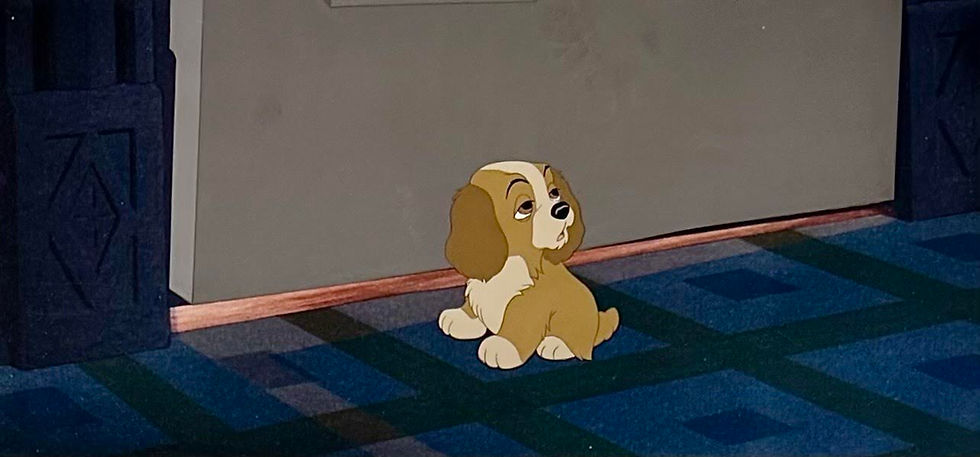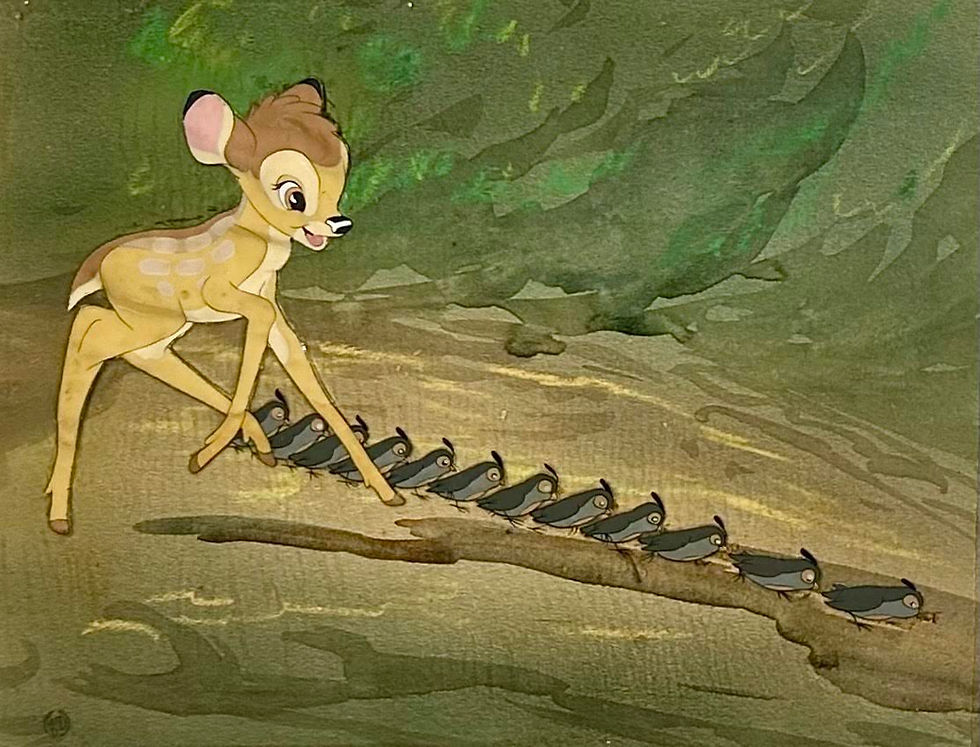Original Animation Cel of Mushrooms from "The Nutcracker Suite" sequence of "Fantasia," 1940
- Untitled Art Gallery

- Mar 30, 2020
- 4 min read

Original hand painted and hand inked production animation cel of Six Dancing Mushrooms and Hop Low from "The Nutcracker Suite" sequence of "Fantasia," 1940, Walt Disney Studios; Set on an airbrushed Courvoisier background with the WDP stamp lower left; Walt Disney Productions Copyright stamp verso; With original Courvoisier Galleries label; Size - Six Mushrooms & Hop Low: 4 3/4 x 8 1/4", Image: 10 x 10 3/4"; Unframed.
"Fantasia" is the third full length animated feature film produced by Walt Disney and released by Walt Disney Productions on November 13, 1940. Story direction was by Joe Grant and Dick Huemer and production supervision was by Ben Sharpsteen. The film consists of eight animated segments, each set to a piece of classical music conducted by Leopold Stokowski. Seven of pieces were performed by the Philadelphia Orchestra, and "The Sorcerer's Apprentice" used an ad hoc studio orchestra. A live action introduction to each animated segment was by the Master of Ceremonies, music critic and composer Deems Taylor. The concept of the film was developed as Disney was near the completion of a Silly Symphony, "The Sorcerer's Apprentice;" which was designed to be a comeback role for Mickey Mouse, who had declined in popularity. The production costs for the short had grown higher than it would have been able to earn as a stand alone short, so Disney decided to include it within a full length feature film, along with other classic music created animated shorts. The soundtrack for "Fantasia" was recorded using multiple audio channels and reproduced with "Fantasound;" a pioneering sound reproduction system that made "Fantasia" the first commercial film shown with stereophonic sound. The film was released as a theatrical roadshow in thirteen US cities, and although acclaimed by critics; it was unable to make a profit due to World War II cutting off distribution to the European market, the initial high production costs, and the expense of leasing theaters and installing the "Fantasound" equipment. The film was subsequently reissued multiple times with it's original footage and audio being deleted, modified, and/or restored in each version. "Fantasia" is now the 23rd highest-grossing film of all time in the US, when adjusted for inflation. In 1998 the American Film Institute ranked it as the 58th greatest American film in their "100 Years... 100 Movies" and the fifth greatest animated film in their "10 Top 10" list. In 1990, "Fantasia" was selected for preservation in the United States National Film Registry by the Library of Congress as being, "culturally, historically, or aesthetically significant." A sequel, "Fantasia 2000" was co-produced by Roy E. Disney and was released in 1999. Over 1,000 artists and technicians were used in the making of "Fantasia," resulting in more than 500 animated characters. "The Nutcracker Suite," originally composted by Pyotr Ilyich Tchaikovsky, is made up of selections from the ballet suite underscoring scenes depicting the changing seasons from summer to winter. A variety of dancers are utilized including fairies, fish, flowers, mushrooms, and leaves; and including the music scores of "Dance of the Sugar Plum Fairy," "Chinese Dance," "Arabian Dance," Russian Dance," "Dance of the Flutes," and "Waltz of the Flowers."
Disney's "The Nutcracker Suite" segment of "Fantasia" was principally animated by Art Babbitt and he has credited "The Three Stooges" as a reference for animating the dancing mushrooms in the "Chinese Dance" sequence. His animation was timed to the music score, which he pinned to his desk in order to work out the choreography. This allowed him to relate the action to the melody and counterpoint, as he said, "those nasty little notes underneath... so something has to be related to that." The small cute mushroom represents the trill of Tchaikovsky's flute, while the larger mushrooms plod about to the pizzicato (plucking of the string section of the orchestra). Babbitt admitted that "I don't know a hell of a lot about music," but his successful animation was able to transform music that was originally written for a fantasy ballet into an organic score for mushrooms, inspired to wiggle around like a slap stick group of comedians. The "Chinese Dance" is widely regarded by animation historians as a textbook example of successful character animation. John Culhane in his definitive book "Fantasia" stated that the smallest mushroom Hop Low (although he is not named in the film, he is named in the theatrical trailer) who is out of step with the others, "projects his personality as vividly as any character in the Disney galaxy - yet he has no dialogue, makes no sound, and doesn't even have a face or hands to gesture with." He also says of the scene that it "is the best example of Disney Studio's genius for compression, its ability to spring an entire character from a simple design in motion." Walt Disney's nephew Roy, remembered that "We sold a million little salt and pepper shakers," in the shape of the "Fantasia" mushrooms.
This is one the finest original production animation cels of the Dancing Mushrooms that exists. The Courvoisier setup has the complete group of six Mushrooms plus the smallest mushroom, Hop Low who steals the show! All the Mushrooms are full figure, with no back shots. An important and beautiful vintage Walt Disney Courvoisier set-up, that is perfect for any animation art collection!
#Mushroom #HopLow #Mushrooms #CourvoisierGallery #Fantasia #ArtBabbitt #Nutcracker #Disney #WaltDisney #cel #animation #animationart #untitledartgallery #FredMoore #art #artwork #animationcel #Courvoisier #animationdrawing #productiondrawing #productioncel #MickeyMouse #FantasiaMickey #NutcrackerSuite #ChineseDance #TheNutcrackerSuite






